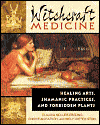
This beautifully-produced book, with numerous color plates of herbs, black and white illustrations, and tables of gods and goddesses and associated herbs, is about “wild medicine,” i.e., traditional pharmacology and herbcraft. Witchcraft medicine “is the healing art of the underground. It is the “forbidden and despised medicine … oppressed by the Church and/or state, the kind of medicine sanctioned as alternative.” It stems from shamanism and “has its roots in Paleolithic times.” It is “mythological, ritualistic, and strongly feminine.” It is “religion—a shamanic healing religion revolving around sacred, in other words, effective, plants” (pp. 80-81).
This may not be the best book to introduce American newbie witches to pagan practices, but if you’ve already read The Great Cosmic Mother, Triumph of the Moon, and some of the works of Marija Gimbutas or Robert Graves, then you will be fascinated to see witchcraft from a European point of view. The authors, who all hold Ph.D. degrees (in anthropology and other fields), live in Germany but have traveled widely. But one of them seems to think that Native Americans still live in “wig-wams,” and another seems to be a really big fan of psychoactive herbs. Because most of our books stick to the Greco-Roman and Norse pantheons, the information we get here is new and useful. It’s important for American readers to remember that during the Reformation and Counter-Reformation (16th and 17th centuries), the fiercest fighting between Protestants and Catholics took place in Germany, and Germany is also where most of the so-called witches were persecuted and murdered. Although parts of the book are romanticized speculation, therefore, when these authors talk about the demonization of goddesses and herbs, they can document it.
The first five chapters, by Storl, are about “the old woman in the hedgerow” who was the traditional village witch/shaman/midwife/“mother of death.” Ratsch’s long “Legacy of Hecate” chapter describes possibly every herb used for magical and medicinal purposes in antiquity. His references are to the gardens of Hecate, Medea, Circe, and Artemis. The first mention of witches’ flying ointment, he says, occurs in the Iliad, where Hera smears herself with ambrosia and travels from Mount Olympus to Mount Ida. Zeus was “profoundly stunned” at how fast she made the trip. Muller-Ebeling discusses the demonization of “the sensuous natural woman” and nature’s healing powers. Our image of the witch, she says, comes from Renaissance art, wherein the Virgin Mary is always shown in a civilized setting (gardens, houses, cities), while witches are always shown in the wild. “If Mary is the rose or the lily among thorns,” she says, “then the witch embodies the thorns” (p. 148).
Be sure to read the footnotes in this book, which the best outside the works of Leonard Shlain. You’ll learn wonderful things. In the 18th century, for example, there was a Great Complete Universal Dictionary of All Sciences and Arts (one wishes we might have such a work today), and the Hindus “use the powdered bark of the poisonous yew tree for their forehead marks.” Here is one of the juiciest footnotes:
Our top-heavy contemporaries—the modern intellectuals and other people who are unable to release themselves from their ego-based reason—often have difficulty conceiving children. … Our sex is not ecstatic, it is not devoted to the gods, it is not in harmony with nature; it is civilized, cramped, and infertile. Sex takes place … inside the mind, following the instructions from the sex manual—unlike the people who are still bound to nature…. But it is precisely [in nature], where the horned god [and] Frau Holle dwell, where the reservoir of joy is found… (p. 63, n. 14).
Who knew??
~review by Barbara Ardinger, Ph.D.
Author: Claudia Muller-Ebeling, Christian Ratsch, & Wolf-Dieter Storl, translated by Annabel Lee
Inner Traditions, 2003
